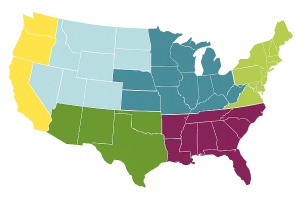Tennessee Native Plants, State Flower & State Bird
Posted By American Meadows Content Team on Sep 27, 2012 · Revised on Oct 26, 2025

Knowing your location helps us recommend plants that will thrive in your climate, based on your Growing Zone.
Posted By American Meadows Content Team on Sep 27, 2012 · Revised on Oct 26, 2025
Native plants are adaptable, low-maintenance, and beautiful. They are the best choice for habitat-friendly gardens and thriving ecosystems. Find top picks for native plants in your state - and learn about your state bird and state flowers!
Follow Along With More Of Our Guides
Hello native plant enthusiasts! In the list below, you will find popular native plants and wildflower seeds, available from American Meadows, that have a native distribution in your state. You’ll also find information about your state bird, state flower, and state wildflower!
Grow our Native Southeast Wildflower Seed Mix!
Virginia Bluebells (Mertensia virginica)
Cliff Goldenrod (Solidago drummondii)
Showy Goldenrod (Solidago speciosa)
Wrinkleleaf Goldenrod (Solidago rugosa)
Black Eyed Susan (Rudbeckia fulgida)
Black Eyed Susan or Gloriosa Daisy (Rudbeckia hirta)
Purple Coneflower (Echinacea purpurea)
Pale Purple Coneflower (Echinacea pallida)
Yellow Prairie Coneflower (Ratibida columnifera)
Gray Headed Coneflower (Ratibida pinnata)
Butterfly Weed (Asclepias tuberosa)
Swamp Milkweed (Asclepias incarnata)
Common Milkweed (Asclepias syriaca)
White Trillium (Trillium grandiflorum)
Red Trillium (Trillium erectum)
Painted Trillium (Trillium undulatum)
White Tinged Sedge (Carex albicans)
Appalachian Sedge (Carex appalachia)
Wild Strawberry (Fragaria virginiana)
Lowbush Blueberry (Vaccinium angustifolium)
Plains Coreopsis (Coreopsis tinctoria)
Lanceleaf Coreopsis (Coreopsis lanceolata)
Wild Bergamot (Monarda fistulosa)
Wild Geranium (Geranium maculatum)
Elderberry (Sambucus canadensis)
Phlox divaricata (Woodland Phlox)
Phlox subulata (Creeping Phlox)
Obedient Plant (Physostegia virginiana)
Red Cardinal Flower (Lobelia cardinalis)
Blazing Star (Liatris spicata)
Meadow Anemone (Anemone canadensis)
Bottlebrush Grass (Elymus hystrix)
Muhly Grass (Muhlenbergia capillaris)
Big Bluestem (Andropogon gerardii)
Little Bluestem (Schizachyrium scoparium)
Northern Sea Oats (Chasmanthium latifolium)
Yellow Prairie Grass (Sorghastrum nutans)
Smooth Blue Aster (Symphyotrichum laeve)
Aromatic Aster (Symphyotrichum oblongifolium)
New England Aster (Symphyotrichum novae-angliae)
Sky Blue Aster (Symphyotrichum oolentangiense)
Common White Yarrow (Achillea millefolium)
Heliopsis (Heliopsis helianthoides)
Purple Prairie Clover (Dalea purpurea)

Mockingbird ~ Mimus polyglottos
Intensely territorial, the Mockingbird stands ready to attack any creature that invades his domain, especially fellow Mockingbirds. The bird’s continuous imitation of other sounds may be designed to better express individual differences.
Iris ~ Iris
There are more than two hundred species of Irises that grow wild, and thousands of hybrids, but all have two common characteristics: sword-shaped leaves and a distinctive flower structure consisting of three upright petals, called standards, and three outer petals, or sepals, that hang down from the base of the blossom. The arrangement of these parts is peculiar and their duties unusual. A bee, instead of settling on the petals that arch upward from the flower’s center, uses the broad sepals as a landing field. The sepals curve downward and have honey-guide markings and sometimes golden beards. Irises come in a stunning range of colors – hence the name Iris, after the Greek goddess of the rainbow.
From The Wildflowers of the 50 States U.S. stamps issued July 24, 1992:

